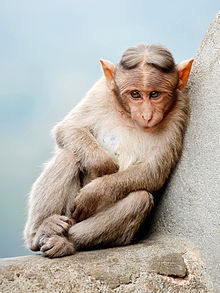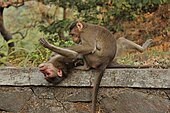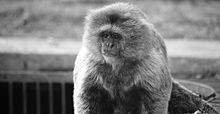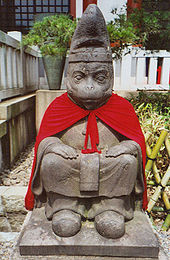Monkey
History
Monkey are haplorhine ("dry-nosed") primates, a paraphyletic group generally possessing tails and consisting of approximately 260 known living species. Many monkey species are tree-dwelling (arboreal), although there are species that live primarily on the ground, such as baboons. Most species are also active during the day (diurnal). Monkeys are generally considered to be intelligent, particularly Old World monkeys.
Lemurs, lorises, and galagos are not monkeys; instead they are strepsirrhine ("wet-nosed") primates. Like monkeys, tarsiers are haplorhine primates; however, they are also not monkeys. There are two major types of monkey: New World monkeys (platyrrhines) from South and Central America and Old World monkeys (catarrhines of the superfamily Cercopithecoidea) from Africa and Asia. Hominoid apes (gibbons, orangutans, gorillas, chimpanzees, and humans), which all lack tails, are also catarrhines but are not considered monkeys. (Tailless monkeys may be called "apes", incorrectly according to modern usage; thus the tailless Barbary macaque is sometimes called the "Barbary ape".) Because Old World monkeys are more closely related to hominoid apes than to New World monkeys, yet the term "monkey" excludes these closer relatives, monkeys are referred to as a paraphyletic group. Simians ("monkeys") and tarsiers emerged within haplorrhines some 60 million years ago. New World monkeys and catarrhine monkeys emerged within the simians some 35 millions years ago. Old World monkeys and Hominoidea emerged within the catarrhine monkeys some 25 millions years ago. Extinct basal simians such as Aegyptopithecus or Parapithecus [35-32 million years ago] are also considered monkeys by primatologists.Historical and modern terminology
Monkeys often groom socially.
Later in the first half of the 20th century, the idea developed that there were trends in primate evolution and that the living members of the order could be arranged in a series, leading through "monkeys" and "apes" to humans. Monkeys thus constituted a "grade" on the path to humans and were distinguished from "apes".
Scientific classifications are now more often based on monophyletic groups, that is groups consisting of all the descendants of a common ancestor. The New World monkeys and the Old World monkeys are each monophyletic groups, but their combination is not, since it excludes hominoids (apes and humans). Thus the term "monkey" no longer refers to a recognized scientific taxon. The smallest accepted taxon which contains all the monkeys is the infraorder Simiiformes, or simians. However this also contains the hominoids (apes and humans), so that monkeys are, in terms of currently recognized taxa, non-hominoid simians. Colloquially and pop-culturally, the term is ambiguous and sometimes monkey includes non-human hominoids. In addition, frequent arguments are made for a monophyletic usage of the word "monkey" from the perspective that usage should reflect cladistics.
A group of monkeys may be commonly referred to as a tribe or a troop.
Description
Goeldi's marmoset (Callimico goeldii)
Some characteristics are shared among the groups; most New World monkeys have prehensile tails while Old World monkeys have non-prehensile tails or no visible tail at all. Old World monkeys have trichromatic color vision like that of humans, while New World monkeys may be trichromatic, dichromatic, or—as in the owl monkeys and greater galagos—monochromatic. Although both the New and Old World monkeys, like the apes, have forward-facing eyes, the faces of Old World and New World monkeys look very different, though again, each group shares some features such as the types of noses, cheeks and rumps.
Relationship with humans
The many species of monkey have varied relationships with humans. Some are kept as pets, others used as model organisms in laboratories or in space missions. They may be killed in monkey drives (when they threaten agriculture) or used as service animals for the disabled.In some areas, some species of monkey are considered agricultural pests, and can cause extensive damage to commercial and subsistence crops. This can have important implications for the conservation of endangered species, which may be subject to persecution. In some instances farmers' perceptions of the damage may exceed the actual damage. Monkeys that have become habituated to human presence in tourist locations may also be considered pests, attacking tourists
In religion and culture, the monkey often represents quick-wittedness and mischief.
As service animals for the disabled
Some organizations train capuchin monkeys as service animals to assist quadriplegics and other people with severe spinal cord injuries or mobility impairments. After being socialized in a human home as infants, the monkeys undergo extensive training before being placed with a disabled person. Around the house, the monkeys assist with feeding, fetching, manipulating objects, and personal care.In experiments
Main article: Animal testing on non-human primates
The use of monkeys in laboratories is controversial.
Sam, a rhesus macaque, was flown to a height of 55 miles (89 km) by NASA in 1959
In space
Main article: Monkeys and apes in space
A number of countries have used monkeys as part of their space
exploration programmes, including the United States and France. The
first monkey in space was Albert II, who flew in the US-launched V-2 rocket on June 14, 1949.As food
Monkey brains are eaten as a delicacy in parts of South Asia, Africa and China. In traditional Islamic dietary laws, the eating of monkeys is forbidden. However, monkeys are sometimes eaten in parts of Africa, where they can be sold as "bushmeat".Literature
Illustration of Indian monkeys known as bandar from the illuminated manuscript Baburnama (Memoirs of Babur)
Monkeys are prevalent in numerous books, television programs, and movies. The television series Monkey and the literary characters Monsieur Eek and Curious George are all examples.
Simian statue at a Buddhist shrine in Tokyo, Japan
The winged monkeys are prominent characters in The Wizard of Oz.
Religion and worship
Hanuman, a prominent divine entity in Hinduism, is a human-like monkey god. He bestows courage, strength and longevity to the person who thinks about him or the god Rama.In Buddhism, the monkey is an early incarnation of Buddha but may also represent trickery and ugliness. The Chinese Buddhist "mind monkey" metaphor refers to the unsettled, restless state of human mind. Monkey is also one of the Three Senseless Creatures, symbolizing greed, with the tiger representing anger and the deer lovesickness.
The Mizaru, or three wise monkeys, are revered in Japanese folklore, together they embody the proverbial principle to "see no evil, hear no evil, speak no evil".
The Moche people of ancient Peru worshipped nature.They placed emphasis on animals and often depicted monkeys in their art.
The Tzeltal people of Mexico worshipped monkeys as incarnations of their dead ancestors.
Zodiac
The Monkey (猴) is the ninth in the twelve-year cycle of animals which appear in the Chinese zodiac related to the Chinese calendar. This year is the year of the monkey. |
| Sam, a rhesus macaque, was flown to a height of 55 miles (89 km) by NASA in 1959. |






No comments:
Post a Comment